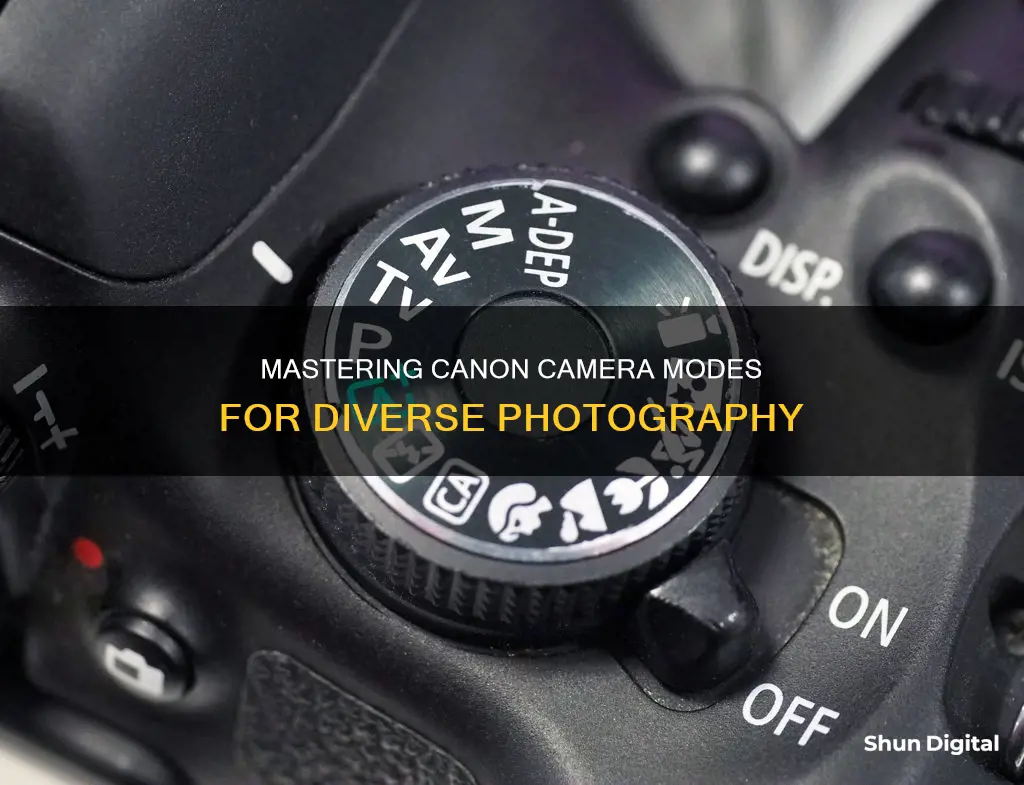
The mode you use on your Canon camera depends on the type of shot you want to take. Canon cameras have a range of modes, from fully automatic to fully manual, with some semi-automatic modes in between. The basic modes are Programmed Automatic (P), Shutter-Priority (S/Tv), Aperture-Priority (A/Av), and Manual (M). Canon cameras also have additional modes, such as Full Auto Mode, Landscape Mode, Sports Mode, Close-Up Mode, Portrait Mode, and Night Portrait Mode.
If you want to have full control over your camera settings, you should use Manual Mode. This allows you to adjust the aperture, shutter speed, ISO, and white balance to your desired levels. However, this mode can be time-consuming and may cause you to miss certain shots.
If you want to control the depth of field in your images, Aperture Priority Mode is a good choice. This mode allows you to set the aperture while the camera automatically adjusts the shutter speed. It is often used for portraits or macro photography, where capturing motion is not a priority.
Shutter Priority Mode is useful when you need to freeze or blur motion. With this mode, you can set the shutter speed while the camera chooses the appropriate aperture. It is commonly used for sports photography or photos of moving water.
Programmed Automatic Mode is similar to Full Auto Mode, but it gives you more control over certain settings. The camera automatically adjusts the shutter speed and aperture, but you can manually adjust the exposure compensation, ISO setting, and white balance. This mode is useful when you don't want to spend time deciding on the shutter speed and aperture.
Each mode has its advantages and disadvantages, and the best mode to use depends on your specific needs and preferences.
| Characteristics | Values |
|---|---|
| Program Mode (P Mode) | Camera automatically adjusts shutter speed and aperture; user can manually adjust exposure compensation, ISO setting and white balance |
| Shutter Priority Mode (Tv/S Mode) | User decides shutter speed; camera adjusts aperture |
| Aperture Priority Mode (Av/A Mode) | User adjusts aperture; camera automatically sets shutter speed |
| Manual Mode (M Mode) | User adjusts all settings |
What You'll Learn

Aperture Value (AV)
Aperture Value, denoted by AV on Canon cameras, is a semi-automatic mode that gives you control over the depth of field in your images. In this mode, you select the aperture setting, and the camera automatically adjusts the shutter speed to maintain the correct exposure.
The aperture refers to the opening of the lens through which light enters the camera. This is measured using f-numbers or f-stops, which indicate how wide or narrow the aperture is. A lower f-number denotes a wider aperture, which allows more light to enter the camera and creates a shallower depth of field. Conversely, a higher f-number indicates a narrower aperture, letting in less light and resulting in a deeper depth of field.
In AV mode, you can easily adjust the f-number by rotating the main dial above the shutter button on your Canon camera. This setting is displayed on the back LCD screen. By choosing a smaller f-number, you can achieve a blurry background, perfect for portraits where you want to highlight the subject. On the other hand, selecting a larger f-number will bring both the foreground and background into sharp focus, making it ideal for landscape photography.
AV mode is an excellent choice when you want to experiment with different depths of field without worrying about shutter speed. The camera will automatically adjust the shutter speed to compensate for the amount of light entering the lens based on your chosen aperture. This mode is a great tool to have creative control over your images while still benefiting from the camera's automatic settings.
Understanding Adobe Camera Raw: A Plugin Essential
You may want to see also

Time Value (TV)
Canon cameras have a mode called TV, which stands for Time Value, but is also known as Shutter Priority Mode. In this mode, the user selects a shutter speed, and the camera adjusts the aperture size to correctly expose the image.
TV mode is useful when you want to experiment with capturing motion in different ways. For example, if you're photographing a fast-moving subject like an athlete, you can use a fast shutter speed to freeze their motion. On the other hand, if you want to add some drama and impact to your shot, you can slow down the shutter speed to blur the motion. This mode is great for sports photography, as it allows you to capture the dynamic movements of athletes.
TV mode gives you control over how you freeze motion by either speeding up or slowing down the shutter speed. It's a good mode to start with if you're a beginner because it allows you to understand camera features and build your confidence. With TV mode, you can adjust the shutter speed directly to capture silky-smooth water images using a slow shutter speed, or freeze the action of a fast-moving subject like a motorcyclist with a faster shutter speed.
Additionally, TV mode is useful when dealing with subjects of varying brightness. By choosing the appropriate shutter speed, you can ensure that the camera pairs it with the right aperture to capture the scene accurately.
Understanding Raw Camera Shooting: Capturing Unprocessed Images
You may want to see also

Program Mode (P)
- Turn the camera mode dial to "P". On smaller cameras without a mode dial, locate the mode options in the menu or quick menu and select Program Mode.
- Test or check the exposure and compensate if needed. Use exposure compensation to correct the image if it is too light or too dark.
- Set the ISO based on the lighting conditions. For outdoor shots in bright sunlight, use a lower ISO like ISO 100. For indoor or low-light settings, use a higher ISO like ISO 3200 or higher.
- Frame your photo, focus by half-pressing the shutter button, and adjust any auto settings if needed. You can adjust settings like metering mode, white balance, focus area, etc.
- Shoot your photo. Remember that once the photo is taken, the camera will re-evaluate the scene and select new settings, so you may need to adjust again.
Program Mode is a great mode for beginners as it allows you to make quick adjustments while also learning about exposure settings. It gives you more control than Auto mode but is less complex than Manual mode.
Where to Buy Camera Batteries: Walgreens and Beyond
You may want to see also

Shutter Priority Mode
When using Shutter Priority Mode, you can choose from a range of shutter speeds, from 1/8000th of a second to several minutes, depending on the effect you want to create. A faster shutter speed will freeze movement, while a slower shutter speed will blur movement.
Monthly Fees for Cellular Cameras: What's the Deal?
You may want to see also

Aperture Priority Mode
To use Aperture Priority Mode, you must first enter the mode by turning the PASM dial to "A" (or "Av" on Canon cameras). Secondly, you manually select your desired aperture (f-stop). Thirdly, select the proper exposure compensation to avoid overexposing any important highlights in your image. And finally, pick the right ISO value. If your subject is stationary and you are shooting with a tripod, it is recommended to stick to the base ISO, which is usually ISO 100.
Dash Cam Power: Staying Charged and Ready
You may want to see also
Frequently asked questions
Shutter Priority Mode (Tv/S) is the best mode for sports photography as it allows you to freeze the motion of fast-moving subjects. You can set a fast shutter speed and the camera will select a wide aperture to match.
Aperture Priority Mode (Av/A) is a good choice for portraits as you can create a shallow depth of field, blurring the background and keeping the subject in focus.
You can use Aperture Priority Mode (Av/A) to ensure your landscape photos are crisp and in focus from the foreground to the background. Alternatively, you can use Manual Mode (M) to give yourself full control over the camera settings and capture the scene exactly as you want.







